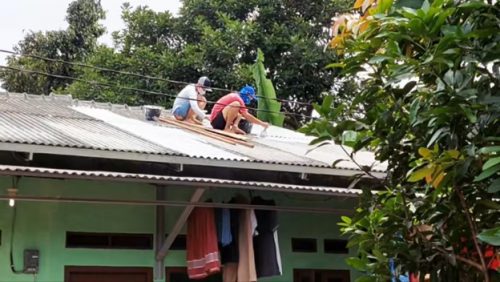
Cool Roof Challenge – Kigali Efficiency Program is a research developed by Beta Paramita Lecturer of Architecture Faculty of Technology and Vocational Education (FPTK) Universitas Pendidikan Indonesia. Graduated from Doctoral Program at the University of Kitakyushu Japan, Beta Paramita is an active researcher in various professional organizations such as RDI (Research Resilience Initiative) which focuses on community, change, environment and sustainable development as well as the Association of Indonesian Building Performance Simulation.
The research project titled Million Cool Roof Challenge was supported by Kigali Efficiency Program. Basically, this research project is the production of coating which can be used on the roof as well as on the walls to reflect the heat of the sun so that the surface of the roof and the area underneath the coating remains cold. This research project was developed to spread the cold roof to reduce the phenomenon of Urban Heat Island in cities with high daily temperatures in Indonesia. The scope of this project has covered 50,000m2 of roof area of several buildings in the city of Tangerang, Jakarta, Jepara, Manado, Pontianak, Kupang, Pamengpeuk and Cikelet-Kab.Garut,and Ciheras-Kab.Tasikmalaya. They type of the buildings covered includes industrial buildings (factories), residential (MBR houses), mosques, elementary schools and government offices.
As a project manager, Beta Paramita developed her research project under the Technology and Materials Science Lab of the Faculty of Technology and Vocational Education (FPTK) of the Universitas Pendidikan Indonesia in collaboration with the University of Florida and Millennium Solution, United States of America (USA).
Currently, the Cool Roof Challenge – Kigali Efficiency Program project serves the sale of paint products with a painted area range of more than 1000m2, roof coating consultation for a large scale of more than 1,000m2, building performance measurements include thermal performance, sick building syndrome and optimization of energy use for industries, offices and communities.
On a hot day, a black roof can reach over 150°F (66°C), radiating heat into the building below, as well as the surrounding area. By applying a specially-designed solar-reflective coating to a building’s roof, it absorbs less of the sun’s radiation, reducing internal temperatures by multiple degrees and improving thermal comfort for the building’s inhabitants.
Beta’s team saw some of the Million Cool Roofs Challenge’s most impressive reductions in indoor temperatures. In one industrial building covering 5,000 m2, indoor temperatures dropped by around 20°F (11°C), from 104°F (40°C) to 85°F (29.4°C) following the application of the cool roof coating. And at an elementary school, a cool roof helped reduce indoor temperatures by 5.4°F (3°C).
Beta and her team expanded the use of cool roofs in Indonesia under the Challenge, coating 70 buildings across 15 cities. In total, the team estimates that more than 10,000 people will benefit from the new cool roofs. And since winning the Challenge, Cool Roofs Indonesia has used some of its prize money to install cool roofs on more than 40 public and community buildings, with a plan to continue to deploy the technology at a similar rate over the coming years.
Cool Roofs Indonesia’s water-based product is simple to apply. It consists of a primer, or undercoat, that dries in 30 minutes and a coating that reflects 84% of solar energy and radiates 90% of absorbed heat. After it is weathered, the levels drop to 77% and 88% respectively.